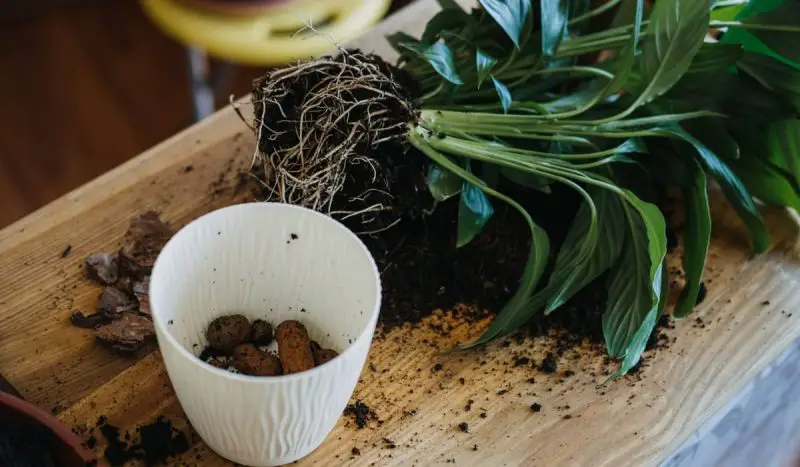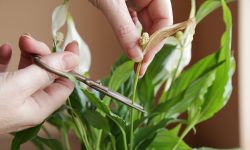Peace lily remains one of the most rewarding indoor plants for growers who love lush foliage and elegant white blooms. It responds well to gentle care and adapts easily to a range of indoor environments. Many plant lovers choose peace lilies because they offer beauty, resilience, and the ability to purify indoor air. Propagation allows you to expand your collection without purchasing new plants. It also helps rejuvenate older plants by giving their root systems more space to grow. When you propagate correctly, each new plant inherits the same strength and vitality as the parent. Understanding how peace lilies divide and form new growth helps you create healthy young plants that thrive quickly.
Growing new peace lilies becomes simple when you understand their natural rhythm and root structure. The plant develops clusters called crowns, which create opportunities for division. Each crown contains leaves, stems, and roots that can grow independently once separated. Propagation gives these crowns more room to breathe and absorb nutrients. The process becomes enjoyable when done with care, patience, and attention to detail. Peace lilies grow quickly after division when given balanced moisture, warm temperatures, and gentle light. Each new plant shows fresh energy as roots settle and leaves expand. With the right approach, you can create multiple healthy peace lilies from a single parent and enjoy long-lasting indoor beauty.
Understanding How Peace Lilies Naturally Multiply

Peace lilies grow through a clumping root system that expands outward as the plant matures. Each clump forms a separate crown that carries its own leaves and root network. These crowns stay connected beneath the soil but can survive independently once divided. This growth pattern allows peace lilies to produce multiple new plants without complex techniques. The plant’s natural structure makes propagation straightforward and reliable. Understanding how these clumps develop helps you identify the best time to divide them. When the plant becomes crowded, each crown competes for moisture and nutrients, which slows overall growth. Division restores balance and supports healthier development.
As peace lilies mature, their crowns grow tighter and begin producing new shoots from the center and edges. These shoots signal that the plant prepares for expansion. When the pot becomes full, the leaves press together and soil dries faster than usual. These signs reveal that the plant seeks more room. Crowded roots also limit oxygen flow and reduce hydration. Dividing the plant gives each crown fresh space to expand. Once separated, each new section adapts quickly to healthier soil and steady moisture. This transition supports faster recovery and stronger root formation.
Propagation succeeds when you understand the plant’s response to environmental changes. Peace lilies stay resilient but grow best when conditions remain stable. Warm temperatures, indirect light, and balanced moisture support active root division. Each new crown strengthens when given consistent hydration and clean soil. Observing leaf color and texture helps you track early changes. Fresh leaves show bright green tones and firm structure. These signs indicate healthy adaptation after propagation. With steady care, each new peace lily becomes a strong and independent plant with long-term growth potential.
Preparing Your Tools and Materials Before Propagation
Successful peace lily propagation begins with careful preparation of tools and materials. Using clean, sharp tools helps you make smooth cuts without damaging delicate roots. A disinfected knife or pruning shears prevents bacteria from entering fresh root surfaces. You will also need fresh potting soil with a loose, airy structure that drains well. A small trowel helps you handle roots gently while moving each division. Preparing clean pots in advance ensures a smooth transition for every new plant. When all materials stay organized, you can work calmly and avoid unnecessary stress on the crowns.
Soil quality plays a major role in the plant’s recovery after propagation. Peace lilies prefer soil that holds moisture but still allows airflow around the roots. A blend designed for indoor tropical plants usually works best. Adding perlite improves drainage and prevents compacted soil from choking new roots. Fresh soil also carries balanced nutrients that help each division adapt quickly. Avoid using old soil because it often contains compacted pockets and reduced oxygen levels. Clean, soft soil supports healthy root expansion and encourages the plant to form new leaves. Each division thrives when the soil environment matches its natural needs.
Pot selection also influences long-term success. Choose pots with drainage holes to prevent water from collecting at the bottom. Standing water reduces oxygen and increases the risk of rot. Small to medium pots help each division establish roots without extra moisture sitting in unused soil. Plastic pots retain moisture evenly, while ceramic pots support airflow around the root zone. Either option can work when moisture stays balanced. Prepare all pots before dividing the plant so each crown moves quickly into its new container. Smooth transitions help reduce transplant shock and encourage faster development.
Separating Healthy Crowns for Successful Peace Lily Propagation
Separating peace lily crowns requires patience and gentle handling. Begin by removing the plant from its pot and loosening the soil around the roots. This step helps you see the structure clearly without breaking delicate root fibers. Each crown should appear as a cluster of leaves rising from its own base. Healthy crowns show firm, bright leaves and roots that look white or light tan. Avoid dividing sections that appear weak or discolored because they need more time to recover. Working slowly allows you to protect the plant’s natural structure and avoid stress during separation.
Once the roots become visible, look for natural dividing points where crowns already pull slightly away from each other. These sections will separate more easily with minimal pressure. Gently ease the crowns apart using your fingers rather than pulling forcefully. If roots tangle, use a gentle stream of water to help free them. This prevents tearing and preserves healthy tissue. Each division should contain several leaves and a strong root mass. Weak divisions struggle to adapt, so focus on creating stable sections that grow well in new soil. Proper division ensures each new plant develops independently.
After separating the crowns, examine each root cluster carefully. Trim away damaged roots with clean scissors to prevent rot. Keeping the roots clean and healthy supports a strong beginning. Allow the divisions to rest briefly before potting so any small breaks can settle. This short rest reduces shock and supports early healing. Once prepared, each crown can be placed into its own pot with fresh soil. Smooth transitions prevent stress and encourage rapid root expansion. With careful separation, each new peace lily begins its growth cycle with strength and stability.
Planting Newly Divided Peace Lilies in Fresh Soil
Planting each peace lily division correctly helps the plant settle into its new environment with minimal stress. Begin by preparing pots filled with loose, moist soil that drains well. Fresh soil supports early root expansion and prevents compaction around delicate roots. Place each crown in the center of the pot and spread the roots gently. Avoid planting too deep because buried crowns struggle to breathe. Position the plant so the base of the leaves sits slightly above the soil surface. This placement helps prevent excess moisture from collecting around the crown.
After positioning the division, fill the pot slowly with soil while supporting the crown. Press the soil lightly to ensure stability without forcing it too tightly. Roots need space to expand, so avoid compressing the soil. Once the plant sits firmly, water gently to settle the soil around the roots. The first watering should hydrate the soil but not soak it heavily. Excess water during early days increases the risk of stress. Place the newly planted division in bright indirect light to encourage early recovery. Stable light helps nourish the plant without overwhelming its soft roots.
During the first week, observe moisture closely because roots remain sensitive. Keep the soil slightly damp but never wet. Allow the top layer to dry lightly before adding more water. This routine prevents root damage and helps divisions adapt faster. Limit movement or repotting adjustments during this period because early stability supports root anchoring. Avoid fertilizer until new leaves appear. Young roots absorb nutrients slowly, so early feeding may cause stress. When leaves stand firm and show fresh color, the plant has settled. Proper planting creates a strong foundation for rapid peace lily growth.
Creating Ideal Conditions for Fast Root Recovery
Peace lily divisions root quickly when their environment stays warm, stable, and gently humid. Newly separated crowns rely on steady conditions to regain strength. Warm temperatures support active cell growth and help roots form new tips. Bright indirect light supplies enough energy for recovery without stressing tender leaves. Avoid direct sunlight because it heats the soil too quickly and dehydrates soft tissue. A calm environment helps each division adjust smoothly after separation. When the plant feels secure, roots settle faster and leaves lift with renewed firmness.
Humidity also influences early root development. Peace lilies prefer moderate humidity that prevents leaf edges from drying. Light misting helps maintain moisture around the foliage but must be done carefully. Mist only during the morning to avoid prolonged wetness at night. Consistent airflow keeps excess moisture from lingering on the leaves. Stagnant air encourages fungal activity, which harms recovering roots. A balanced climate strengthens the plant and supports healthy hydration. With stable humidity, new roots expand more confidently and anchor themselves deeper in the soil.
Soil moisture becomes a key factor during the first stages of recovery. Slightly damp soil helps young roots absorb water without drowning them. Allow the top layer to dry slightly before adding more moisture. Overwatering causes decay and slows adaptation, while underwatering stresses the crowns. Observing soil texture helps you adjust watering at the right moment. As roots strengthen, the plant responds with firm leaves and brighter color. Each sign of improvement shows that conditions support healthy development. With consistent care, divisions adapt well and grow into strong, independent peace lilies.
Caring for Newly Propagated Peace Lilies During Early Growth
Newly propagated peace lilies need gentle care as their roots adjust to fresh soil. During the first few weeks, the plant focuses on building root strength rather than producing new leaves. This period requires patience and steady conditions. Keep the plant in warm rooms where temperatures remain stable. Avoid drafts from windows or air conditioners because sudden shifts stress the roots. Bright indirect light helps support early recovery without overwhelming fragile leaves. When the environment stays predictable, the plant establishes itself more quickly and begins forming new growth.
Moisture plays a major role in early stability. Water the plant lightly and allow the top soil layer to dry before watering again. Consistent but controlled hydration helps the roots absorb moisture at a natural pace. Overwatering prevents proper oxygen flow and slows development. Underwatering weakens the plant and reduces its ability to form strong roots. Humidity also supports early leaf strength by preventing dryness at the edges. Maintain moderate humidity levels without letting moisture linger on leaf surfaces. Balanced humidity encourages smooth recovery and keeps foliage firm.
As the plant strengthens, look for signs of new growth. New leaves appear slowly at first and then increase as roots expand. During this stage, avoid fertilizing because young roots cannot process nutrients efficiently. Feeding too early can cause leaf burn and unnecessary stress. Instead, focus on maintaining a clean, stable environment. Keep the soil loose, the light soft, and the air fresh. Once new leaves reach full size, the plant becomes ready for regular care routines. Early patience ensures each propagated peace lily grows into a healthy, vibrant plant.
Avoiding Common Mistakes When Propagating Peace Lilies
Preventing Overwatering and Root Stress
Overwatering remains the most frequent issue during peace lily propagation because young roots need oxygen as much as moisture. When soil stays wet for too long, air pockets collapse and roots lose access to oxygen. This creates soft, weak tissue that cannot support new growth. Waterlogged soil also encourages harmful bacteria that spread quickly through tender divisions. Many growers water too soon, assuming new plants need extra moisture. In reality, peace lily divisions prefer a gentle rhythm that allows the top layer to dry before the next watering. Understanding this balance reduces stress and strengthens root formation.
To prevent root damage, monitor soil texture regularly instead of following a strict schedule. Slight dryness at the surface indicates that the plant needs more water. Use pots with drainage holes to release excess moisture and keep airflow active around the root zone. Avoid soaking the soil during the first weeks because new roots absorb water slowly. Light watering supports gradual development and prevents early rot. Allowing water to drain fully after each session protects young crowns. When moisture stays balanced, each division adapts smoothly and grows with better stability.
Protecting Divisions From Light and Temperature Shock
Newly separated peace lily crowns remain sensitive to light intensity and temperature fluctuations. Direct sunlight damages soft leaves and dehydrates the plant faster than it can recover. Strong rays also heat the soil, which slows root formation and increases stress. Cold drafts from windows, doors, or air vents shock the roots and reduce hydration. These sudden changes disrupt the plant’s internal balance and delay recovery. Keeping the environment steady ensures that each crown rebuilds energy without pressure. Peace lilies always respond better to gentle conditions during early growth.
To avoid shock, place divisions in bright indirect light where exposure stays consistent. Filtered light provides enough energy without overwhelming delicate tissue. Keep the plant away from drafty areas or cold surfaces that release temperature drops. Maintain warm indoor conditions and avoid moving the plant too often. Early movements disrupt root anchoring and slow adaptation. Patience becomes essential during the first weeks because stability supports strong recovery. With protected conditions, new leaves appear sooner and roots strengthen with less resistance.
Choosing the Right Soil and Pot Size
Soil quality significantly influences how quickly a peace lily recovers after division. Old soil becomes compacted and restricts airflow around the roots. Compaction slows moisture movement and creates uneven hydration. New roots struggle in this environment because they need loose, breathable soil to expand. Using oversized pots also slows growth because extra soil retains moisture that roots cannot absorb. This leads to damp pockets that increase the risk of rot. Many growers make this mistake because they assume larger pots support faster growth. Instead, smaller pots create a controlled environment for early root development.
Selecting fresh, airy soil ensures that roots receive both moisture and oxygen. A smaller pot supports hydration balance and reduces the chance of oversaturation. Fill the pot with a loose soil blend that drains well and remains soft after watering. Avoid pressing the soil tightly around the roots. Allow young crowns to settle naturally and expand at their own pace. Delay fertilizing until new leaves appear because early feeding overwhelms tender roots. Once growth stabilizes, the plant becomes ready for normal care routines. Proper soil and pot choices ensure strong development and long-term health.
Troubleshooting Slow or Stalled Peace Lily Growth After Propagation
Slow growth after propagation often begins when the plant struggles to adapt to its new environment. Newly divided crowns need time to rebuild strength, so early development may progress more slowly than expected. If growth remains stalled, the plant may experience inconsistent moisture or weak light exposure. Soil that dries too quickly can reduce hydration and limit root activity. Soil that stays wet for long periods restricts oxygen and slows growth as well. Observing each division closely helps you identify which factor limits its progress. Peace lilies respond positively once conditions stabilize and remain predictable.
Light plays a major role in early growth speed. Newly propagated peace lilies cannot process low light as efficiently as mature plants. Weak light delays leaf formation and reduces overall energy. However, strong sunlight also creates stress by heating the soil and dehydrating tender leaves. Finding the balance between brightness and protection supports faster recovery. Place the plant near filtered windows where brightness stays steady throughout the day. Avoid moving the plant often because it disrupts root development. Stable light allows the plant to build energy gradually and resume healthy growth over time.
Nutrient imbalance can also slow progress after propagation. Newly formed roots absorb fertilizer slowly, so early feeding causes stress. If the plant lacks essential nutrients, growth may slow even when other conditions seem appropriate. Wait until new leaves appear before introducing dilute fertilizer. Proper humidity also influences recovery, especially in dry rooms. Moderate humidity keeps leaf edges healthy and prevents early drooping. With gentle adjustments to light, moisture, and airflow, each division gains strength. Once the roots settle deeply, peace lilies resume their natural rhythm and produce firm, vibrant leaves.
Encouraging Blooming After Successful Peace Lily Propagation
Peace lilies often take time to bloom after propagation because the plant focuses first on rebuilding root strength. Newly divided crowns direct most of their energy toward stabilizing themselves in fresh soil. Once roots expand and hydration becomes consistent, the plant transitions into a growth phase that prepares it for future blooms. Stable temperatures, bright indirect light, and controlled moisture help accelerate this process. When environmental conditions remain steady, the plant gradually rebuilds energy reserves needed to produce healthy white blooms.
Light becomes the strongest influence on post-propagation flowering. Peace lilies need bright indirect light to form blooms, but they cannot tolerate strong sun after division. Gentle, steady brightness supports photosynthesis without damaging tender leaves. If the plant receives too little light, bloom production slows or stops. If light becomes too intense, leaves may scorch before flowers form. Position the plant near windows with filtered light or in warm rooms with soft, stable brightness. As the plant grows stronger, leaves widen, and the central stems prepare to push new flower spikes. Proper light increases bloom frequency and strengthens each emerging spadix.
Moisture balance also shapes the plant’s ability to bloom. Continuous overwatering weakens roots and prevents bloom formation. Underwatering creates stress that redirects energy away from flowering. Maintain a gentle watering rhythm that keeps soil evenly moist but never saturated. Humidity supports bloom development by preventing leaf dryness and maintaining steady hydration. Avoid feeding too early, but once new leaves expand fully, introduce a diluted fertilizer to support bloom formation. With the right conditions, peace lilies begin producing elegant white flowers that reflect strong recovery and balanced growth.
Maintaining Long-Term Health for Propagated Peace Lilies
Long-term care ensures that each propagated peace lily grows with stable strength and vibrant foliage. After the early recovery phase, the plant begins to adapt fully to its environment. Consistent routines help it maintain balanced hydration and firm leaf texture. Keeping the plant in warm rooms with steady airflow prevents moisture buildup and reduces stress. Clean soil encourages healthy root function and supports gentle nutrient absorption. As the plant matures, its leaves widen and show deeper green tones. Stable conditions protect the plant from sudden decline and support long-lasting vitality.
Regular monitoring prevents small issues from becoming major problems. Watch for yellow leaves, drooping stems, or overly dry soil, as these signs indicate imbalance. Correcting conditions early helps the plant recover without losing strength. Bright indirect light remains essential, especially as the plant grows larger and produces more foliage. Rotating the pot encourages even light distribution and prevents leaning. Avoid placing the plant in cold corners or areas with inconsistent temperatures. Stable humidity keeps leaf edges smooth and prevents dryness. These simple habits improve overall resilience and ensure steady growth throughout the year.
Feeding also contributes to long-term health when done correctly. Once the plant establishes strong roots and forms new leaves, begin using a diluted fertilizer during warm months. This supports active growth and helps the plant maintain energy. Always feed lightly to prevent stress on sensitive roots. Refresh the soil every year to improve texture and drainage. Repot only when the roots become crowded, because peace lilies prefer slight confinement. With proper care, each propagated peace lily grows into a mature plant with lush foliage and balanced structure. Consistent routines ensure it remains healthy, strong, and beautiful for many years.
FAQs About How to Propagate Peace Lily
How long does it take a propagated peace lily to grow new leaves?
New leaves usually appear within three to six weeks after propagation. Growth depends on light, moisture, and temperature. Warm rooms and bright indirect light speed recovery. Stable moisture also helps roots strengthen. Once roots anchor fully, new leaves emerge with firm texture and healthy green color.
Why is my newly propagated peace lily drooping?
Drooping often comes from moisture imbalance or temperature stress. Overwatering reduces oxygen and weakens roots, while underwatering dehydrates the crown. Cold drafts also cause sudden drooping. Keep the plant warm and adjust watering slowly. Once conditions stabilize, leaves regain firmness and return to healthy posture.
Can I propagate a peace lily from a leaf cutting?
Peace lilies do not grow from leaf cuttings. They must be propagated through division because each new plant requires its own crown and root system. Leaf cuttings cannot develop independent roots. Division creates strong, healthy sections that continue growing with proper care and balanced moisture.
When should I fertilize a recently propagated peace lily?
Wait until new leaves appear before adding fertilizer. Young roots absorb nutrients slowly and may burn easily. Use diluted fertilizer during warm months for gentle feeding. Avoid feeding during early recovery. Stable moisture and indirect light help divisions gain strength before nutrient supplements become beneficial.
Why isn’t my propagated peace lily blooming yet?
Blooming slows after propagation because the plant rebuilds root strength first. Low light, unstable moisture, or cold temperatures may also delay blooms. Keep the plant in bright indirect light and avoid overwatering. Once conditions stabilize, the plant regains energy and produces healthy white flowers.
Conclusion
Propagating peace lilies becomes simple when you understand their natural structure and growth rhythm. Gentle handling, balanced moisture, and warm light help each division recover quickly. Stable humidity and clean soil support strong root development. Observing small changes allows you to correct issues before they spread. With consistent care, each new plant grows with confidence and produces vibrant foliage. Over time, the divisions mature into healthy peace lilies that brighten indoor spaces. Propagation not only expands your collection but also strengthens older plants. With patience, every propagated peace lily thrives and adds lasting beauty to your home.






